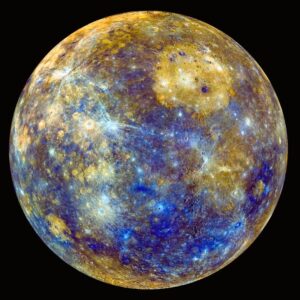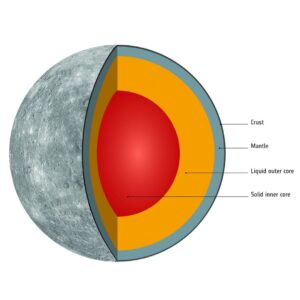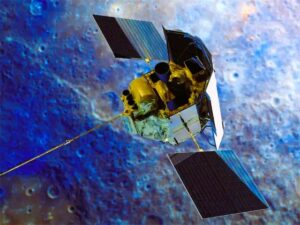- abaashishb7
- April 1, 2024
- 10:08 am
- No Comments
Mercury Planet
बुध ग्रह

* Mercury Planet : The Swift Messenger of Our Solar System
Mercury, named after the Roman messenger god, is the smallest and innermost planet
in our solar system. With its proximity to the Sun and unique characteristics, Mercury
offers a fascinating glimpse into the dynamics of planetary formation and evolution.
Let’s delve into the details of this swift and enigmatic world.
* Discovery of Mercury:
Mercury, the innermost planet of our solar system, has been observed and known to
humanity since ancient times. However, its formal discovery, as in the recognition of its
nature as a planet orbiting the Sun, does not have a single individual credited with its
discovery.
1:- Ancient Observations: Various ancient civilizations, including the Sumerians,
Babylonians, Greeks, and Egyptians, observed Mercury in the night sky. They
recognized it as a celestial object but did not understand its true nature.
2:- Greek Naming: The Greeks named the planet after their messenger god, Hermes. The
Romans later equated Hermes with their own messenger god, Mercury, hence the
name “Mercury.”
3:- Kepler’s Theories: In the 17th century, Johannes Kepler’s laws of planetary motion
helped in understanding This Planet’s orbit around the Sun. His theories laid the
groundwork for later observations and calculations.
4:- Modern Confirmation: In the 1960s, radar observations confirmed This planet’s
rotation period and provided more accurate measurements of its orbital
characteristics.
* Dimensions
This Planet is the smallest planet in our solar system, so its dimensions are relatively
modest compared to the gas giants like Jupiter or even the Earth. Here are some key
dimensions of This Planet
Diameter at the equator : Approximately 4,880 kilometers (3,032 miles)
Diameter at the poles : Approximately 4,879 kilometers (3,031 miles)
Average diameter : Approximately 4,880 kilometers (3,032 miles)
Circumference at the equator : Approximately 15,329 kilometers (9,525 miles)
* Key Facts about Mercury:
1:- Distance from the Sun: This Planet orbits the Sun at an average distance of about 36
million miles (58 million kilometers).
2:- Orbital Period: A year on This Planet (the time it takes to orbit the Sun once) is
equivalent to about 88 Earth days.
3:- Rotation: Interestingly, This Planet rotates very slowly on its axis. A day on This Planet
(one complete rotation) takes approximately 59 Earth days. This means a day on
This Planet is longer than its year!
4:- Surface Temperature: Due to its proximity to the Sun and lack of atmosphere to
retain heat, This Planet experiences extreme temperature variations. Daytime
temperatures can soar up to 800 degrees Fahrenheit (430 degrees Celsius), while
nighttime temperatures plummet to around -290 degrees Fahrenheit (-180 degrees
Celsius).
5:- Surface Features: This Planet’s surface is characterized by vast plains, rugged
mountains, and numerous impact craters. These craters, caused by collisions with
asteroids and comets, give This Planet a heavily cratered appearance. Some of the
most notable features include the Caloris Basin, a massive impact crater, and the
expansive smooth plains of the northern hemisphere.
6:- Thin Atmosphere: Unlike Earth, This Planet has a very thin and tenuous atmosphere,
primarily composed of small amounts of hydrogen, helium, and oxygen. Its
atmosphere is constantly bombarded by the solar wind, which sweeps away any
gases that attempt to accumulate.
7:- Magnetic Field: One of the most intriguing aspects of This Planet is its relatively
strong magnetic field, considering its small size. This magnetic field is believed to be
generated by a dynamo effect within its partially molten iron core.
* Mercury’s Structure:
1:- Core: Mercury has a large iron core that makes up about 60% of its mass. This core is
likely partly molten and is responsible for generating the planet’s magnetic field.
2:- Mantle: Surrounding the core is a silicate mantle, though it is much thinner than
Earth’s mantle.
3:- Crust: Mercury’s surface crust is relatively thin compared to other planets, and it is
heavily cratered due to its lack of geological activity. The presence of volatiles, such
as water ice, has been detected in the permanently shadowed regions near the poles.
* What Would Happen if a Human Were to Enter Mercury:
Mercury’s extreme conditions make it a highly inhospitable planet for humans. If a
human were somehow able to survive the journey and land on Mercury, they would face
numerous challenges due to the planet’s harsh environment:
1:- Extreme Temperature Fluctuations: Mercury’s proximity to the Sun causes extreme
temperature variations. Daytime temperatures can soar up to 800 degrees Fahrenheit
(430 degrees Celsius), hot enough to melt lead. Nighttime temperatures drop to
around -290 degrees Fahrenheit (-180 degrees Celsius). A human without proper
protection would quickly succumb to these temperature extremes.
2:- Thin Atmosphere: Mercury has a very thin and tenuous atmosphere, primarily
composed of small amounts of hydrogen, helium, and oxygen. This thin atmosphere
provides virtually no protection from the intense solar radiation and cosmic rays that
bombard the planet’s surface.
3:- No Liquid Water: Due to its proximity to the Sun and lack of atmosphere, Mercury
does not have liquid water on its surface. Any water present would likely be in the
form of ice in permanently shadowed regions near the poles.
4:- High Surface Gravity: Despite its small size, Mercury has a relatively high surface
gravity compared to its size. This would make movement on the planet’s surface
more challenging for a human.
5:- No Protective Magnetic Field: While This Planet has a magnetic field, it is much
weaker than Earth’s. This means that the planet offers little protection from solar
winds and radiation, which could pose serious health risks to humans.
if a human were to somehow land on This Planet, they would face extreme
heat, cold, radiation exposure, lack of breathable air, and harsh surface conditions.
Without advanced technology and protective gear, survival on This Planet’s surface would
be impossible for humans.
* Exploration of Mercury:
Mercury Planet
1:- Mariner 10 (1974-1975): The first spacecraft to visit This Planet, Mariner 10 provided
the first close-up images of the planet and discovered its magnetic field.
2:- MESSENGER (Mercury Surface, Space Environment, Geochemistry, and Ranging):
Launched in 2004 and arriving at This Planet in 2011, NASA’s MESSENGER mission
provided a wealth of data about the planet. It mapped This Planet’s surface in detail,
studied its magnetic field, and confirmed the presence of water ice on the planet.
3:- BepiColombo: A joint mission by the European Space Agency (ESA) and the Japan
Aerospace Exploration Agency (JAXA), BepiColombo launched in 2018 and arrived at
This Planet in 2025. This mission aims to further study Mercury’s composition,
magnetic field, and surface features.
* Moon
Despite not having any moons, This Planet remains a fascinating object of study, with its extreme temperatures, heavily cratered surface, and unique characteristics that continue to intrigue scientists and astronomers.
- abaashishb7
- April 1, 2024
- 10:08 am
- No Comments






